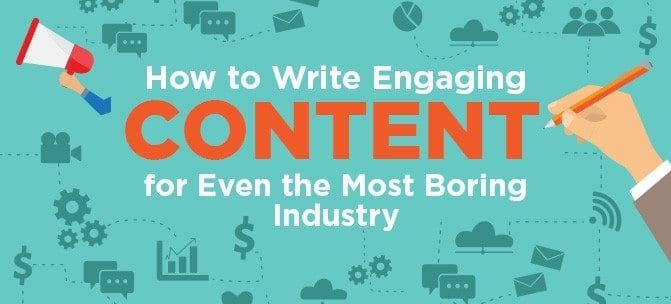If someone asked you to come up with a list of boring industries, what would you include? Lighting fixtures? Plumbing? Electronics manufacturing? Housecleaning?
We get it. Writing meaningful content about plumbing issues can seem like a near-impossibility. And when you’re the one tasked with writing that content, it can lead to an uncomfortable number of hours spent staring at a blank computer screen.
However, it can be done! We’re including lots of tips on how to do this below, but first, you have to embrace this one, basic truth: no industry is truly boring.
How do you write engaging content for a boring industry? Remember: no industry is truly boring. Click To Tweet
So how do you get at this intriguing, non-boring side of the industry you’re writing about? The tips below should help you out.
Research the industry (or product, if that’s what you’re writing about) until you have a good idea of how it works, the trending issues related to it, and what customers seem to love or hate about it.
If you’re someone who works in the industry you’re writing about, you already have a strong grasp on all kinds of topics that would make great blog posts.
But that doesn’t mean you can’t learn more. In this case, it might be helpful to look at your industry from a different angle – maybe interview someone at your company whom you don’t work with on a regular basis, or talk to a few loyal customers about what they like about your product.
Now, if you’re a content writer who writes about all different types of industries, doing research is a no-brainer. How else are you going to write decent content?
With a so-called “boring” industry, however, it can take a lot more effort to make yourself dig in and gain more than a superficial understanding of the industry. Yet that’s where all the interesting information lies.
Take something like commercial real estate law. Researching the ins and outs of buying, selling, and leasing commercial buildings sounds exhausting (unless you’re a real estate agent, of course), but that’s the only way you’ll find out that in some states, sellers must disclose suspected hauntings to potential buyers. And there’s nothing boring about a haunted building.
Check your brand voice.
No matter how complex, dry, or uninteresting your industry may be to the internet masses, you can always inject life into your material by creating an engaging brand voice.
This is true of literally any industry. Even if your target audience is Ph.Ds, there’s no value in having a pedantic, inaccessible brand voice – all it will do is make people stop reading.
One of the best examples of a company that’s created a strong (and funny) brand voice is the Dollar Shave Club. Their online commercial from 2012 caught the eye of more than 23 million people with its outlandish title, “Our Blades are F***ing Great,” and the irreverent absurdity of its founder and star. And I don’t know about you, but razors aren’t exactly thrilling.
Instead, establish a voice that’s friendly, knowledgeable, and jargon-free. This will allow you to maintain authority on your subject matter, without boring readers to death. If you’re still working on defining your brand voice, read our post “5 Steps to Developing an Outstanding Brand Voice on Social Media.”
Be specific, instead of vague.
Specificity is always preferable in writing, but this is especially true when you’re writing about a difficult industry. A topic like “New Lighting Fixtures from Europe” will get you a few clicks – but “The Latest European Lighting Fixture Styles from 4 Parisian Showrooms” will earn you a whole lot more.
That’s because vague topics are almost always boring, even if you’re writing about an inherently interesting industry like fashion design or moviemaking. Think of it like gossip: when you’re talking with your friend about the date they went on last night, and they were only giving you a general outline of their evening, what would you say? “Details! Give me details!”
It’s the details that we want, whether we’re discussing a potential new flame or developments in the manufacturing industry. Without them, we just tune out.
Vague topics are always boring. Give your reader specificity and details. #contentmarketing Click To TweetInclude stories or real-life examples.
You’re probably tired of hearing how absolutely crucial storytelling is to writing engaging content, so all we’ll say is: It’s 100 percent true.
And when it comes to boring industries especially, stories and real-life examples are your lifelines. This goes hand-in-hand with being specific. You want to give your reader something concrete that they can anchor onto, something that makes them think, “Oh, maybe I can relate to this topic.”
You don’t have to be a master of fiction in order to craft a good story, and the story you tell doesn’t have to be life-changing or epic, either. All it has to do is give the reader a specific individual or situation to focus on.
This has been a mainstay of journalism for decades because it makes for a much more compelling read. When you’re scrolling through the news, which of these first sentences would make you continue reading the article:
“Ashlyn is one of the first people I meet at Meeting Street Academy, a charter school serving underprivileged children in Charleston, S.C.”
Or:
“Meeting Street Academy is a charter school serving underprivileged children in Charleston, S.C.
I don’t know about you, but I’d really want to know who Ashlyn is.
Don’t just think outside the box, tear the box apart.
When you know the industry you’re writing about, you can find all sorts of different angles to use in your content. But how do you find an angle that no one has covered, that no one has even thought of?
What you do is give yourself some time for totally uncensored brainstorming. Let yourself go way outside the boundaries of your industry and even of the form you’re using – I’d be willing to be that’s how whoever invented the vlog made the jump from written blogs to video blogs.
Here’s a real-life example of that (see what I did there?). One of my favorite podcasts is Science Vs., which is published by the podcasting company Gimlet Media. Now, Science Vs. is a fascinating podcast, but that’s not why I brought it up here. I brought it up to talk about the ads.
Gimlet Media runs ads from their sponsors on all their podcasts, but they’re unlike nearly any ad you’ve heard before (or they used to be before other companies began copying the approach).
Instead of talking about the product that the sponsor offers, they zoom way, way out to find the most interesting thing about the company that they can – then, they make a kind of ultra-mini-podcast about that thing.
For example, one of their sponsors is a small business insurance company, Hiscox Insurance. One of the ads Gimlet made for Hiscox involved an interview with one of Hiscox’ customers, a former convict named Coss Marte who created a fitness business offering customers prison-style boot camp workouts with other ex-cons as trainers. It’s called ConBody. (To give credit where credit is due, Hiscox also has a write-up about ConBody on their site. It’s another great example of engaging content in a boring industry.)
Now, if I’d heard a typical ad that just promoted Hiscox’ insurance offerings, I’m almost positive I would have tuned out as soon as I heard the word “insurance.” But I heard this particular ad months ago, and I still remember it.
That’s what you want your content to do: stick in the reader’s mind because it’s just too interesting to forget.
Use visuals whenever possible.
Just like those visual aids you used to incorporate into your middle school presentations, visual elements in your blog posts can help pique a reader’s interest – even if they’re not particularly interested in the topic you’re writing about.
Visuals can also help break up a lengthy piece of text, which is especially important when the topic you’re covering is complex (which, by the way, is often what people mean when they say something is boring – it’s boring because it’s difficult to understand).
Write efficiently.
Writing efficiently simply means using the fewest words you need to get across the idea you want to convey. In other words: get to the point.
This is a good rule to follow in all your content marketing, of course, but it will really help you hang on to readers when you’re writing about something confusing, complex, dry, or just plain dull. With topics like these, most of your readers are reading your content because they need to: they either need to learn from the information you’re presenting, or they need to get an educated opinion on your industry.
Whichever reason it is, these readers don’t want to spend time reading 16 paragraphs when you could have said it in 6.
Now, that may make it sound as if incorporating storytelling into your content is a waste of your reader’s time. But actually, if you include stories to illustrate a point and not just for the sake of including them, you really are being efficient, because you’re explaining something in a more effective way.
When you’re writing content for a boring industry, the first thing to remember is that no industry is completely boring. If you dig deep enough, you’re bound to uncover something blog-worthy. If you’re having trouble coming up with ideas, read our post “Mad Hatter Brainstorming.”








